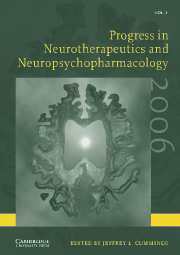Book contents
- Frontmatter
- Contents
- Preface
- Contributors
- Introduction to neurotherapeutics and neuropsychopharmacology
- Rivastigmine in the treatment of dementia associated with Parkinson's disease: a randomized, double-blind, placebo-controlled study
- Modafinil for the treatment of fatigue in multiple sclerosis
- Radiotherapy with concurrent and adjuvant temozolomide: a new standard of care for glioblastoma multiforme
- Treating migraine attacks ASAP: concept and methodological issues
- Early phase trials of minocycline in amyotrophic lateral sclerosis
- Creatine as a potential treatment for amyotrophic lateral sclerosis
- AVP-923 as a novel treatment for pseudobulbar affect in ALS
- Liquid fluoxetine versus placebo for repetitive behaviors in childhood autism
- Testing multiple novel mechanisms for treating schizophrenia in a single trial
- Selegiline in the treatment of negative symptoms of schizophrenia
- Analysis of the cognitive enhancing effects of modafinil in schizophrenia
- Efficacy and tolerability of ziprasidone and olanzapine in acutely ill inpatients with schizophrenia or schizoaffective disorder: results of a double-blind, six-week study, with a six-month, double-blind, continuation phase
- Subject index
- Author index
AVP-923 as a novel treatment for pseudobulbar affect in ALS
Published online by Cambridge University Press: 22 March 2010
- Frontmatter
- Contents
- Preface
- Contributors
- Introduction to neurotherapeutics and neuropsychopharmacology
- Rivastigmine in the treatment of dementia associated with Parkinson's disease: a randomized, double-blind, placebo-controlled study
- Modafinil for the treatment of fatigue in multiple sclerosis
- Radiotherapy with concurrent and adjuvant temozolomide: a new standard of care for glioblastoma multiforme
- Treating migraine attacks ASAP: concept and methodological issues
- Early phase trials of minocycline in amyotrophic lateral sclerosis
- Creatine as a potential treatment for amyotrophic lateral sclerosis
- AVP-923 as a novel treatment for pseudobulbar affect in ALS
- Liquid fluoxetine versus placebo for repetitive behaviors in childhood autism
- Testing multiple novel mechanisms for treating schizophrenia in a single trial
- Selegiline in the treatment of negative symptoms of schizophrenia
- Analysis of the cognitive enhancing effects of modafinil in schizophrenia
- Efficacy and tolerability of ziprasidone and olanzapine in acutely ill inpatients with schizophrenia or schizoaffective disorder: results of a double-blind, six-week study, with a six-month, double-blind, continuation phase
- Subject index
- Author index
Summary
Key words: Pseudobulbar palsy; pathologic laughing; pathologic crying; dextromethorphan; quinidine; amyotrophic lateral sclerosis; multiple sclerosis; clinical trial; neurotherapeutics.
Introduction and Overview
Pseudobulbar affect (PBA) is a neurologic condition characterized by the disinhibition or loss of control of the motor expression of emotion (Wilson, 1924). Hallmark symptoms of PBA are uncontrollable crying and/or laughing that is out of context with the social setting (Arciniegas & Topkoff, 2000; Dark et al., 1996). The condition can be severe, unremitting, and persistent (Dark et al., 1996). PBA occurs secondary to neurologic diseases or injuries including amyotrophic lateral sclerosis (ALS) (Gallagher, 1989), multiple sclerosis (MS) (Feinstein et al., 1997), stroke (House et al., 1989), traumatic brain injury (Zeilig et al., 1996), Parkinson's disease (Kaschka et al., 2001), and dementia, including Alzheimer's disease (Starkstein et al., 1995). Other terms used to refer to PBA include pathologic laughing and crying (PLC), emotional lability (EL), and emotional incontinence (Dark et al., 1996).
PBA is caused by structural damage to the brain (Dark et al., 1996), possibly resulting from excitotoxic mechanisms underlying the associated neurologic disorder (Mattson, 2003). The end result is disconnection of the regions of the brain that regulate the motor expression of emotion. Under normal conditions, cortical regions (prefrontal, frontal, temporal, and motor), as well as subcortical limbic structures, send modulated signals to the cerebellum and brainstem to coordinate appropriate displays of emotion (Parvizi et al., 2001; Arciniegas & Topkoff, 2000; Mega et al., 1997; Wilson, 1924). It is hypothesized that abnormally increased excitatory, glutamatergic signaling causes the damage underlying a variety of neurologic disease and injury states (Mattson, 2003; Bittigau & Ikonomidou, 1997; Greenamyre, 1986), including a role in all those listed above that are linked with PBA (Mattson, 2003; Matute et al., 2001; Bittigau & Ikonomidou, 1997).
- Type
- Chapter
- Information
- Progress in Neurotherapeutics and Neuropsychopharmacology , pp. 91 - 104Publisher: Cambridge University PressPrint publication year: 2006



